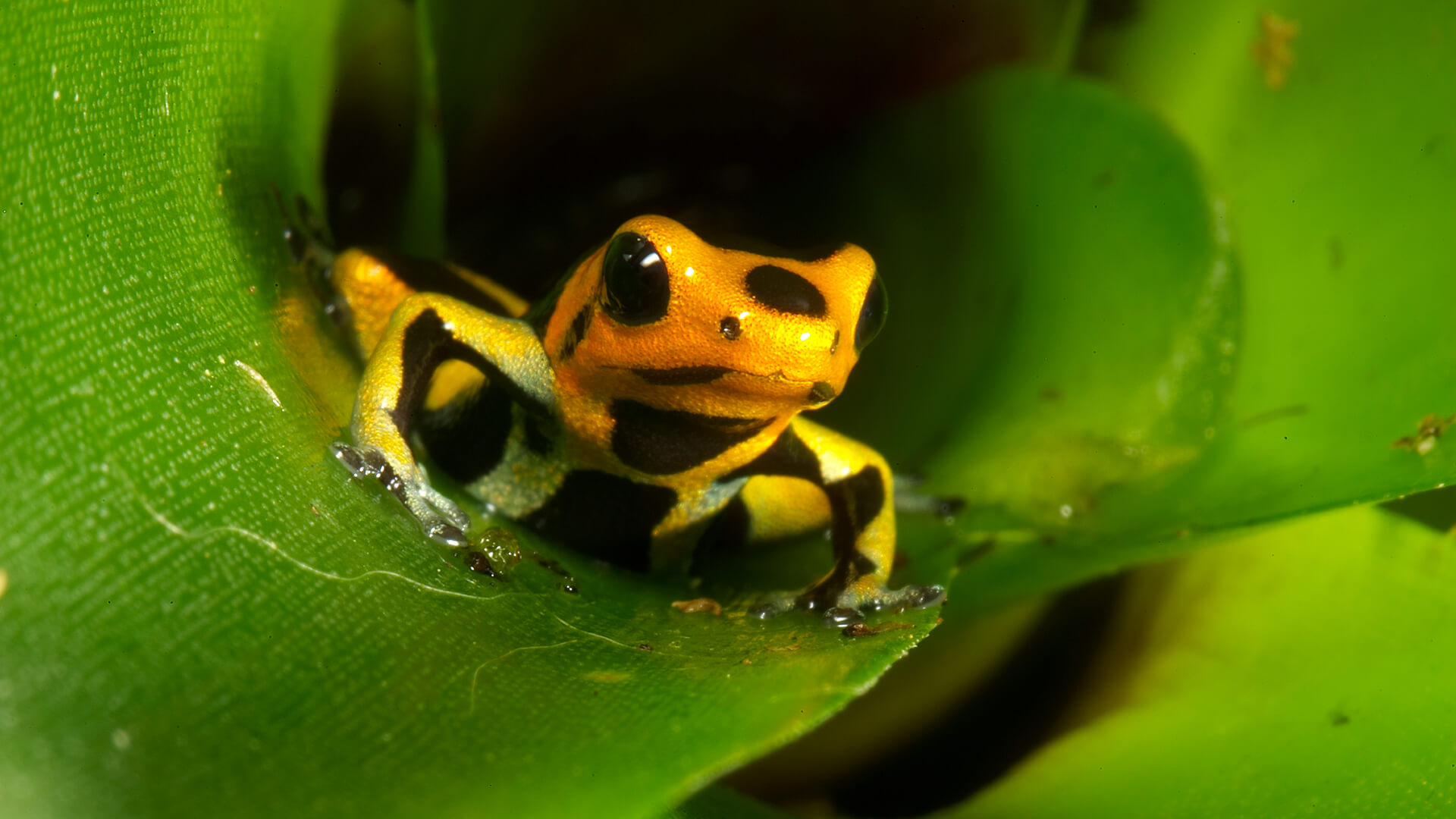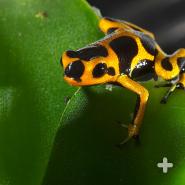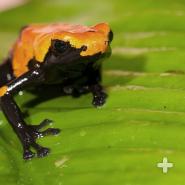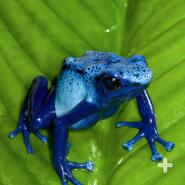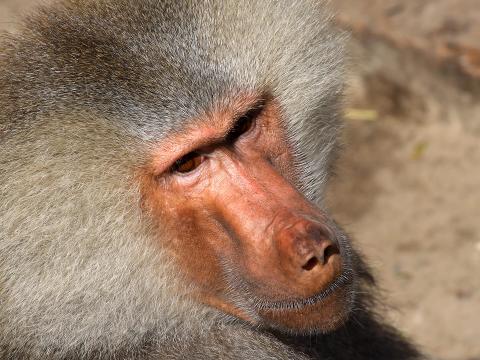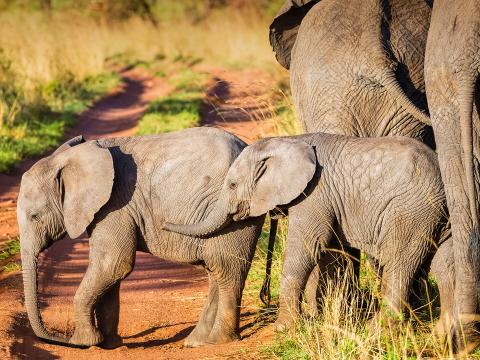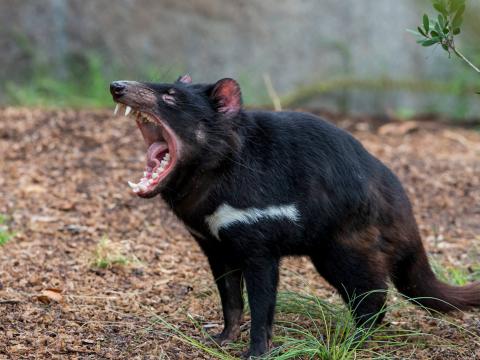Poison Frog
- CLASS: Amphibia (Amphibians)
- ORDER: Anura
- FAMILY: Dendrobatidae
- GENERA: 11
- SPECIES: 220
ABOUT
Here I am—don't eat me! Poison frogs are known as the jewels of the rainforest and come in just about every color combination you can think of: red and black, yellow and green, orange and silver, blue and yellow, green and black, pink and silver. Their sparkling colors, however, are not for beauty but for warning: “Hey! Here I am, and I am poisonous, so don’t even think about eating me!”
Poison frogs are tiny, terrestrial, diurnal frogs that live primarily in leaf litter on the forest floor, but some live high in the forest canopy and may never come down. All are native to warm Central and South American rainforests near streams or ponds. The frogs’ poison is found in their skin, making them too toxic to touch.
While most frogs are considered toxic but not deadly, they are distasteful to a predator and can even be fatal. The poison can cause serious swelling, nausea, and muscular paralysis. If a predator survives the mistake of trying to eat one, it will remember tasting such a frog and will not try to eat anything similar in the future. In this way, an entire population of frogs of a particular color can benefit from the predator’s experience with only one of their kind. However, there is one snake, the Leimadophis epinephelus, that is immune to poison frog toxins and feeds on the little creatures.
Poison frogs are often called poison dart frogs because the Choco people of western Colombia use the poison of one species, the golden poison frog, to coat the tips of the blow darts they use for hunting. The Choco use waxy leaves to pick up the frogs and dip their blow darts in the frogs’ skin secretions. Just a tiny drop can kill the birds and small mammals that the Choco hunt for food. A single golden poison frog, which is no larger than a bottle cap, can supply enough poison for 30 to 50 darts, and the dart's poison remains active for up to a year. Researchers have found this frog’s toxins to be 200 times more potent than morphine and could potentially be used in medicine.
You'll also hear poison frogs called "poison arrow frogs," but that's not accurate. The South American people who hunt with arrows usually coat their arrow tips with plant poisons, not frog poisons. Scientists know of only three frog species used for this purpose, so they suggest calling the family “poison frogs” rather than “poison dart frogs.” To further complicate matters, many species in this frog family are not at all toxic to other wildlife or humans.
Each poison frog species produces a different kind of toxin made up of different alkaloids and other chemicals. Scientists have been investigating medical uses for frog poisons and have discovered that some of these alkaloids may be beneficial for people with certain heart and circulatory conditions. One laboratory has developed a new painkiller from the substances produced by the phantasmal poison frog Epipedrobates tricolor. Named “epibatidine” in honor of the frog, it is 200 times more effective than morphine, without all of the bad side effects! There is a complex chemical process involved in the production of this medicinal pain killer from the "raw" biochemicals of the frog. During this process its efficacy for use in humans is modified to reduce the potency. Poison frog secretions also show promise for the development of muscle relaxants and heart stimulants.
HABITAT AND DIET
The poisons in these tiny frogs come from their diet in their rainforest habitats in Central and South America: mostly ants, termites, centipedes, and tiny beetles. This diversity of food items is required to create the chemical toxins by the frog. Specific toxins are passed from each bug to the frog when eaten, which then collect in glands in the frog’s skin. When they are fed a regular zoo diet, the frogs eventually lose most, if not all, of their toxicity. Those hatched at zoos aren’t poisonous, because they don’t eat the same food as their counterparts in their native habitat.
At the San Diego Zoo and San Diego Zoo Safari Park, poison frogs are fed pinhead crickets, fruit flies, and young springtails.
FAMILY LIFE
Most frogs are nocturnal, but poison frogs are active during the day, when their jewel-colored bodies can best be seen and avoided. The frogs are very social and often stay in pairs or small groups. Males wrestle over territories, females tussle over the best egg-laying sites, and courting pairs nudge and caress one another with their chins and forearms. Things are seldom dull in the poison frog world!
Breeding time begins with poison frogs wrestling with one another, often flipping over an opponent. The winner may secure a territory or a mate, and the females are the most competitive. Courtship, which begins with the male calling and the couple chasing, hopping on, and stroking each other, can last for hours.
Female poison frogs lay small clutches of eggs, from 1 to 30 on average. They usually deposit them in a quiet, dark, moist environment, such as in the base of a bromeliad leaf, the crook in a tree branch, or a small hole in a tree trunk. Both parents help keep the eggs moist and free from fungal growth and predators such as ants.
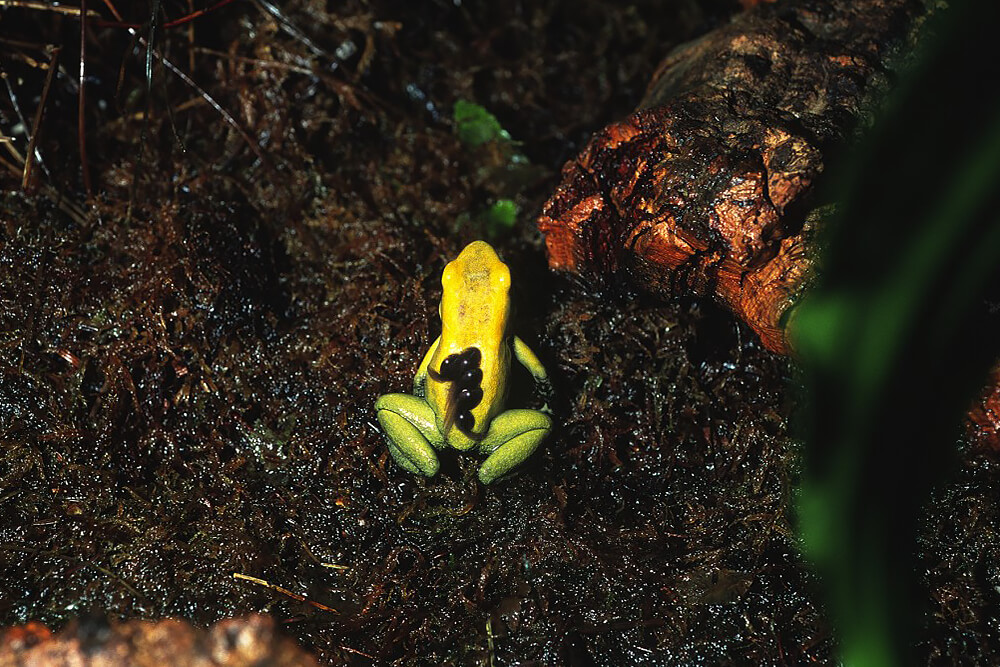
Poison frogs are also unique among amphibians because they are very involved parents and contribute a lot of energy to caring for their eggs and offspring. For example, frogs in the Colostethus genus lay their eggs on the forest floor or on the edge of a leaf. The father guards the eggs until they hatch. The hatchlings, called tadpoles, wriggle out of their gelatin cases onto the father or mother's back. The parents carry their tadpoles to a water source, such as a pond or bromeliad.
Females of other species often return to their tadpoles to lay unfertilized eggs that serve as a food source for the growing youngsters. Other poison frog species lay their eggs directly in water but continue to look after the eggs and tadpoles. And some, like the blue poison frog, tend to eat their siblings as tadpoles, so the parents must find a different water source for each individual hatchling.
The young poison frogs do not look like their parents. As they develop, they change in body shape, diet, and lifestyle, a process all frogs go through called metamorphosis. The young hatch out of their egg as a tadpole with gills to breathe underwater and a tail for swimming. At this point they do not have the poisonous toxins in their skin and so are vulnerable to predators such as snakes and fish. As they get older, they develop lungs, rear legs, and a different mouth.
At about eight weeks, front legs begin to form, and the rear legs continue to develop. Their eyes also change position, and during the 10th week, that tail is absorbed and the color pattern appears. At this point, the tadpole has gradually changed into an adult frog, which spends most of its time hopping on land rather than swimming like a fish in water. Poison frogs are usually mature at about a year and can live 8 to 15 years, depending on the species.
CONSERVATION
Can you imagine a world without frogs? While some poison frog populations are considered stable, their populations aren’t large, and their habitats are rapidly shrinking. These fascinating and beautiful little frogs are threatened by loss of their rainforest habitat and by over-collection for the pet trade. The blue poison frog has become a very popular pet in the U.S., due to its dramatic coloring. Thousands have been smuggled into pet shops all over the world, causing a swift decline in their native habitat.
Another major threat to these tiny frogs is disease. One of those diseases is called chytrid fungus. It grows on the skin of adult frogs and essentially suffocates them, because they’re unable to absorb water and oxygen through their skin. San Diego Zoo Wildlife Alliance conservation scientists have been working collaboratively with other researchers to survey and document the impact of chytrid in Panama. So far, we have not found that poison frogs are greatly impacted by the fungus. However, it is spreading to new areas and at some point, the poison frogs may need rescuing, too.
Biologists consider frogs to be one of the major “canaries in the coal mine,” as frogs are extremely sensitive to small changes in their environment. Disappearing wildlife species are indicators that climate change is having an effect on the Earth’s ecology.
By supporting San Diego Zoo Wildlife Alliance, you are our ally in saving and protecting wildlife worldwide.

